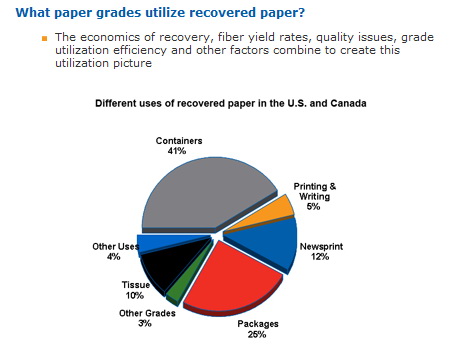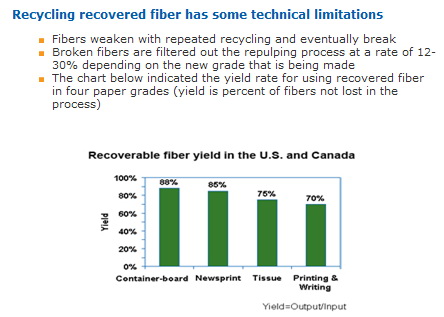Recycled Paper: Be aware of the pitfalls
-----------------
From an environmental perspective the basics of paper recycling are primary-school simple.
1. Recovering and recycling paper is a net positive for the environment.
2. Utilizing recycled fiber in packaging, and the lower quality paper grades (as well as insulation and other industrial applications) is much, much more environmentally healthy than utilizing this fiber in higher quality grades.
This is not to criticize the FutureMark recycling machine that is designed to produce coated groundwood grades, or pulp mills such as the NewPage facility in Duluth that are designed to convert recovered fiber into a pulp quality that works well in the higher quality paper grades.
This FutureMark machine was converted to a coated groundwood recycled machine (from newsprint) to retain financial viability. The higher quality deinking pulp facilities were installed to meet the needs of customers who demanded recycled fiber in SC-A/coated grades. It is unfortunate that such pressures exist, because they create a net negative, from an environmental perspective. Nevertheless, we can’t blame producers for striving to meet customer needs, and taking the steps necessary to stay in business.
Actually there is another reason that I would prefer not to criticize the deinking pulp mill in Duluth (now owned by NewPage). I was responsible for the marketing feasibility study for this facility back in1990 and strongly recommended that the deinking plant go forward.
3. For at least the last decade, and probably the last 15 years, all recovered paper has been recycled. Recovered paper does not go to landfill! A possible exception to this blanket statement would be a short period of time in late 2008 or early 2009 after the financial crisis.
This claim can be verified, by the way, by simply observing the prices of waste paper over time. If waste paper prices (any grade) drop to very low levels, and remain there for a significant period of time then this would indicate a dearth of demand that could then leave landfill as the only option. But that has not happened.
Pressure Applied by Environmental Organizations Leads to Reduced Fiber Recovery and Higher Energy Consumption – Environmental groups, such as Greenpeace and Forest Ethics, continue to threaten and coerce catalogers and other retailers to add recycled fiber to higher quality grades. As we have discussed previously, such initiatives are harmful to the environment! Much more fiber is salvaged and less energy used when recovered fiber is used to produce the lower quality newsprint and packaging grades than when used to produce the higher quality grades.
SC-A/coated producers require recycled fiber that has been specially made for these grades. The process for producing recycled fiber for these higher quality grades is not the same as producing recycled fiber for newsprint or packaging grades. In order to be acceptable for SC-A and coated machines, recovered paper must be put through additional washing and deinking cycles. This extra processing removes “stickies”, dirt, and other contaminates so that machine runnability is preserved and grade quality maintained. However, these additional cycles also destroy a significant portion of the fiber, ie. the fiber yield is much lower.
Pressure Applied by Environmental Organizations Leads to Increased Demand and Higher Prices for Recovered Fiber, and as a Result, the Closure of Many of the Most Efficient Consumers of Recycled Fiber – As our readers who offered comments to this post suggested, increased demand and reduced supply of recovered paper cause higher prices for recycled fiber. As we discussed in that post, these higher prices have been instrumental in the recent closures of four recycled newsprint machines.
The supply of recovered paper is lower because North America is consuming dramatically less paper than it has in years past. (Consumption in Japan and Europe may also be drifting lower). We can not recover paper that is not made in the first place.
Our readers also emphasized that increased demand for recovered paper is primarily due to the fact that China needs our fiber to operate its paper machines.
In addition, however, in spite of the shortage of recovered paper (and thus recycled fiber) Greenpeace, ForestEthics, the Dogwood Alliance, and many other environmental organizations insist on promoting the use of recycled fiber in the higher quality grades. Their motives are selfish and financial. They don’t care if the environment is damaged.
It is very simple. Demand exceeds supply, and will continue to exceed supply for many years. We do not require additional sources of demand for recycled fiber; we need less demand.
Summary – This is not a new story. These facts have been evident for many years. Every cataloger or retailer that requires recycled fiber in its value-added grades is harming the environment and helping drive the more efficient recycled producers out of business.
(The first and third graphs are from a Metafore presentation that can be found here. The price graph is compliments of Equity Research Accociates)
---------------

